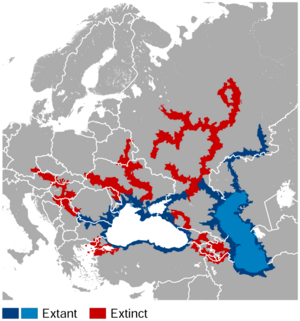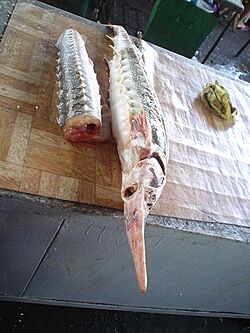Starry sturgeon facts for kids
Quick facts for kids Starry sturgeon |
|
|---|---|
 |
|
| Acipenser stellatus | |
| Conservation status | |
| Scientific classification | |
 |
|
| Starry sturgeon range. | |
| Synonyms | |
|
The starry sturgeon (Acipenser stellatus), also called the stellate sturgeon or sevruga, is a special type of sturgeon fish. It lives in the Black Sea, Sea of Azov, and Caspian Sea. It used to live in the Aegean Sea too, but it has disappeared from there. Scientists are worried that the remaining starry sturgeon populations might vanish soon because too many of them are being caught.
This fish is an anadromous species. This means it lives mostly in saltwater but travels up rivers into freshwater to lay its eggs.
The IUCN (International Union for Conservation of Nature) lists the starry sturgeon as critically endangered. This means it faces a very high risk of disappearing forever. Because of this, international trade of this fish, including its valuable caviar, is limited by CITES rules.
What They Look Like
The starry sturgeon can grow to be about 7.2 feet (220 cm) long. It can weigh up to 176 pounds (80 kg). This fish has a slim body. You can easily tell it apart from other sturgeons by its long, thin, and straight snout.
It has five small barbels (whisker-like feelers) near its mouth. These barbels are closer to its mouth than to the tip of its snout. The scales along its side, called the lateral line, number between 30 and 40. These features help tell it apart from the Russian sturgeon.
The starry sturgeon is usually dark grayish-green or brown on top. Its underside is pale. The scales along its side are also pale. The oldest starry sturgeon ever found was 27 years old.
Life Cycle and Habits
The starry sturgeon is a harmless fish. It mostly eats other fish, worms, crustaceans (like crabs), and mollusks (like snails). During the day, it rests on the bottom of the water. It does most of its feeding at night.
As an anadromous fish, it moves from the sea up into rivers. It goes into shallow waters to lay its eggs. This journey is a key part of its reproduction and life cycle.
Why They Are Important
The starry sturgeon is a very important fish for fishing and food. It is one of the top three types of sturgeon used for making Sevruga caviar. The other two are the Beluga sturgeon and the Ossetra sturgeon.
Its meat is considered a special and expensive food in the Caspian region. People use it to make kabaabs. They also eat it pan-fried, broiled, or smoked.
Scientists in Russia, Iran, Italy, and the United States have tried to raise this fish on farms. This is called aquaculture. They have had different levels of success with these efforts.
This species does not reproduce quickly. It takes a long time for their population to grow. This makes them more vulnerable to problems like overfishing.
See also
- World Sturgeon Conservation Society



